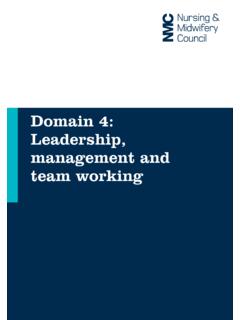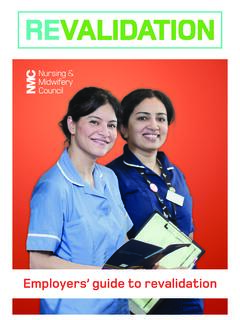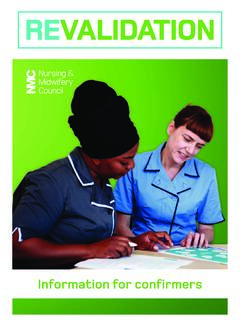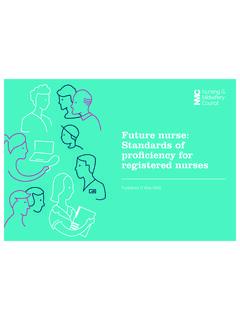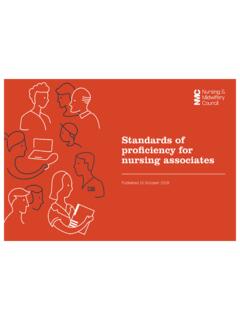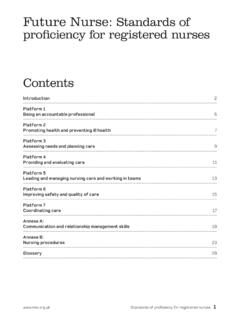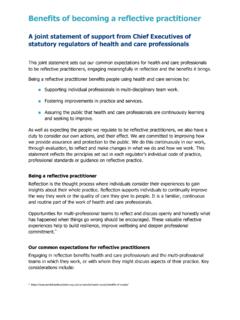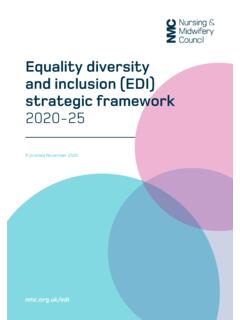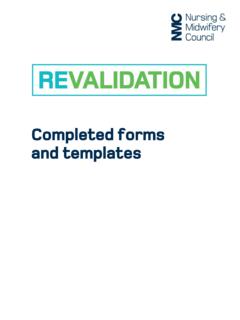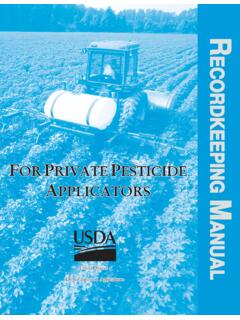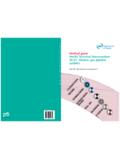Transcription of Standards of Record proficiency for keeping
1 Standards of proficiency for nurse and midwife prescribersProtecting the public through professional standards1 Record keepingGuidance for nurses and midwives15105_Record Keeping_A5_proof 109/03/2010 09:472 ContentsIntroduction .. 4 Legislation and terminology .. 4 Standards of proficiency for nurse and midwife prescribers .. 5 Specialist areas of 6 Section 1 Education and training provision to prepare nurses and midwives to prescribe .. 7 Standards for admission to programmes to be awarded a qualification to prescribe .. 8 Standards for the structure and nature of the preparation of nurse prescribers education programme .. 12 Content of programme of education to achieve NMC proficiencies as a nurse prescriber.
2 15 Standard for assessment .. 23 Section 2 Standards for prescribing practice .. 26 Practice Standard 1 Licence as a prescriber .. 26 Practice Standard 2 Accountability .. 27 Practice Standard 3 Assessment .. 27 Practice Standard 4 27 Practice Standard 5 Consent .. 28 Practice Standard 6 Communication .. 28 Practice Standard 7 Record keeping .. 28 Practice Standard 8 Clinical management plans (supplementary prescribing) .. 29 Practice Standard 9 Prescribing and administration/supply .. 29 Practice Standard 10 Prescribing and dispensing .. 30 Practice Standard 11 Prescribing for family and others .. 30 Practice Standard 12 Computer-generated prescribing by nurses or midwives.
3 31 Practice Standard 13 Evidence-based prescribing .. 31 Practice Standard 14 Delegation .. 31 Practice Standard 15 Continuing professional development .. 32 Practice Standard 16 Controlled drugs .. 32 Practice Standard 17 Prescribing unlicensed medicines .. 34 Practice Standard 18 Prescribing medicines for use outside the terms of the 35 Practice Standard 19 Repeat prescribing .. 36 Practice Standard 20 Remote prescribing via telephone, email, fax, video link or website .. 36 Practice Standard 21 Gifts and benefits .. 373 Section 3 Additional guidance .. 38 Supply and administration via a Patient Group Direction .. 38 Medicines Act exemptions Medicines Act 1968.
4 38 Writing a prescription .. 38 Writing private prescriptions .. 38 Complementary medicinal products .. 38 Dispensing .. 39 Reporting adverse reactions .. 39 Safety of prescription pads .. 39 Professional 40 Section 4 Further information .. 40 Glossary .. 40 Legal classification of licensed medicines .. 45 Resources .. 45 Annexe 1 The history of education and training provision to prepare nurses, midwives and specialist community public health nurses to 47 Annexe 2 Principle areas, knowledge, skills and competencies required to underpin prescribing practice .. 49 Annexe 3 Eligibility criteria for a designated medical practitioner .. 524 IntroductionThe Nursing and Midwifery Council is required by the Nursing and Midwifery Order 2001 (The Order) to establish from time to time Standards of education, training, conduct and performance for nurses and midwives and to ensure the maintenance of those Standards [Article 3 (2)].
5 The Order also states the Council may make rules requiring registrants to undertake such continuing professional development as it shall specify in Standards [Article 19(1)], and in respect of additional qualifications which may be recorded on the register the Council may establish Standards of education and [Article 19(6)].This gives the Council the authority to establish Standards to prepare nurses and midwives to booklet provides the Standards and proficiencies for the programmes of preparation for nurses, midwives and specialist community public health nurses to prescribe as either a community practitioner nurse prescriber or a nurse independent/supplementary prescriber.
6 It replaces all previous requirements issued by the four National Boards for Nurses, Midwives and Health Visitors for England, Wales, Scotland and Northern Ireland. In addition, it provides Standards of conduct that nurses, midwives and specialist community public health nurses are required to meet in their practice as a registered nurse and terminologyThe primary legislation that enables nurses and midwives to prescribe is the Medicinal Products: Prescription by Nurses and Others Act 1992. Chapter 28, Article1(d) of this act defines a nurse prescriber as any registered nurse, midwife or health visitor .Nurses and Midwives (Parts of and Entries in the Register) Order SI 2004/1765 article 7 (2a) replaces any previous reference to health visitor with specialist community public health nurse.
7 Throughout this document where the term nurse independent/supplementary prescriber is used, this refers to nurses, midwives and specialist community public health Further amendments to medicines legislation (SI 2006/1015) have resulted in the following changes, which take effect from 1 May 2006:Previous definitionCurrent definitionDistrict nurse/health visitor formulary nurses and any nurse undertaking a V100 prescribing programme as part of a Specialist Practitioner qualificationCommunity practitioner nurse prescribers (V100)Extended formulary nurse prescribersNurse independent prescribers (V200 only)Extended/supplementary nurse prescribersNurse independent/supplementary prescribers (V300)Throughout this document, the new titles are booklet does not cover.
8 Supply and administration via a Patient Group Direction, or sell, supply or administer via exemption ordersas these are not forms of NMC guidance on the administration of medicines will be revised to take the new titles into of proficiency for nurse and midwife prescribersUnder the new legislation prescribers must have sufficient knowledge and competence to: Assess a patient/client s clinical condition Undertake a thorough history, including medical history and medication history, and diagnose where necessary, including over-the-counter medicines and complementary therapies Decide on management of presenting condition and whether or not to prescribe Identify appropriate products if medication is required Advise the patient/client/client on effects and risks Prescribe if the patient/client agrees Monitor response to medication and lifestyle Standards underpin the principles of prescribing practice within the context of the full scope of nursing/midwifery practice.
9 The Standards are grouped into the following domains: Clinical pharmacology, including the effects of co-morbidity Consultation, history-taking, diagnosis, decision-making and therapy, including referral Influences on, and psychology of, prescribing Prescribing in a team context and sharing information Evidence-based practice and clinical governance in relation to nurse/midwife prescribing Legal, policy and ethical aspects of prescribing Professional accountability and responsibility Prescribing in the public health areas of practiceMedicines are potent treatments and prescribing them can present significant risk to patient/clients. This is especially so for children and older people whose responses may differ from adults.
10 It is essential that registrants recognise the unique implications and developmental context of the anatomical and physiological differences between neonates, infants, children and young people. Caution should also be taken when prescribing for pregnant and lactating programme of preparation (education and training) for prescribing equips nurses midwives and specialist community public health nurses with the principles of prescribing to enable them to be safe, effective and cost-effective prescribers. When an employer considers the suitability of a registrant to develop skills in prescribing, it is their responsibility to ensure that the registrant is able to apply the prescribing principles to their own area of practice.
